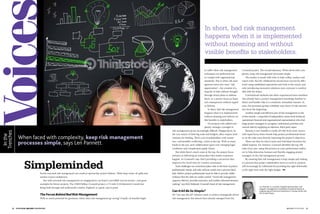
PMN0713 Trenches
- 1. 22 PM NETWORK JULY 2013 WWW.PMI.ORG JULY 2013 PM NETWORK 23 to suffer when risk management techniques are performed just to comply with organizational standards. This is when risk man- agement turns into mere “risk appreciation”—the creation of a long list of risks without thought- through action plans to address them, or a narrow focus on finan- cial consequences without regard to delivery. In short, bad risk management happens when it is implemented without meaning and without vis- ible benefits to stakeholders. On projects with added com- plexity, strategic oversight in risk management grows increasingly difficult. Megaprojects, by the very nature of their big scale and budgets, often require joint ventures for funding. That’s a lot of stakeholders with numer- ous—and possibly conflicting—views at the top. With so many hands in the pot, such collaboration spurs ever-changing legal conditions and complicated supply chains. But while there’s much noise at the top, the project focus remains on delivering an end product that makes customers happier. In Crossrail’s case, that’s providing a rail service that improves the travel time for London commuters. Such challenges can sometimes place risks in the back of project professionals’ minds, and risks will just vanish into a process black hole. Rather, project professionals must be able to provide visible evidence that the risks are under control. “Good risk management supports delivery, provides assurance and enables informed decision- making,” says Rob Halstead, Crossrail’s head of risk management. Can ItAll Be So Simple? No “one-size-fits-all” solution exists to achieve strategically driven risk management, but lessons have already emerged from the 22 PM NETWORK JULY 2013 WWW.PMI.ORG Len Pannett is a London, England-based project and program management consultant focused primarily in engineering and technical industries in Europe, Brazil and the United States. Voice Inthe Trenches When faced with complexity, keep risk management processes simple, says Len Pannett. Poorly executed risk management can result in spectacular project failures. Think deep-water oil spills and nuclear reactor meltdowns. But well-executed risk management on megaprojects can lead to incredible success stories—and great examples for future projects. The US$23 billion Crossrail project, a 73-mile (118-kilometer) transit line being built through and underneath London, England, is a great case in point. The Forces Behind Bad Risk Management With so much potential for greatness, where does risk management go wrong? Usually, its benefits begin Simpleminded Crossrail project. The overall takeaway: When faced with com- plexity, keep risk management processes simple. The market is awash with tools to help collate, analyze and report risks. But Mr. Halstead has found more success by effec- tively using established approaches and tools at the outset, and only introducing innovative solutions once everyone is comfort- able with the basics. Conventional methods also allow experienced team members who already have a project management knowledge baseline to detect and handle risks in a consistent, immediate manner. In turn, this promotes greater reliability and clarity of risk informa- tion from the beginning. Another simple and effective part of risk management is risk review boards—comprised of independent, senior-level technical, operational, financial and organizational representation who chal- lenge project managers to recognize, understand, prioritize and control risks by supplying an objective, third-party input. Because it isn’t feasible to tackle all risks from every source with equal focus, these boards help project professionals home in on the risks most directly impacting the project’s objectives. These can then be tied to team and individual incentives for added impetus. For instance, Crossrail identifies the top 100 risks every year, using this process as a key performance indica- tor to help determine bonuses and thereby engaging project managers in the risk management process. By ensuring that risk management is kept simple and making it a process that project stakeholders strive to excel at, projects will increasingly be celebrated for providing the right deliverable at the right time with the right budget. PM In short, bad risk management happens when it is implemented without meaning and without visible benefits to stakeholders.